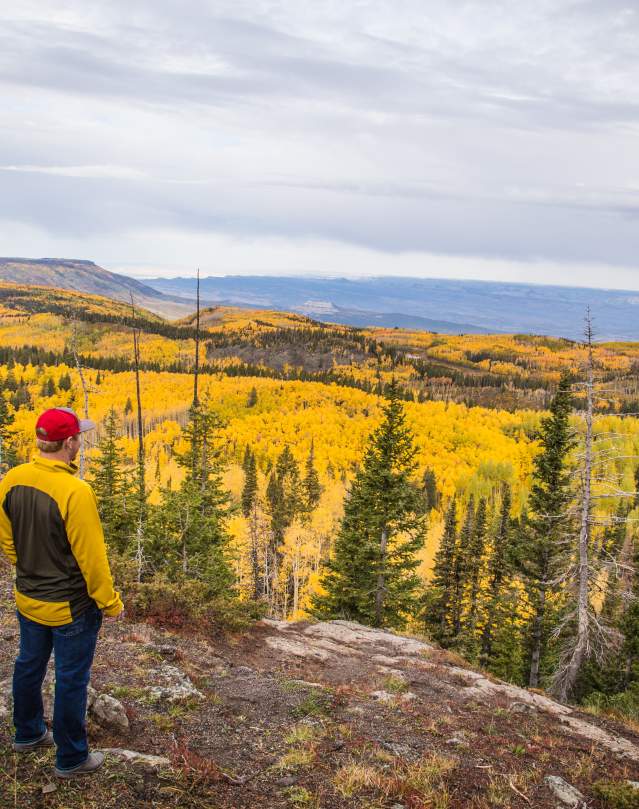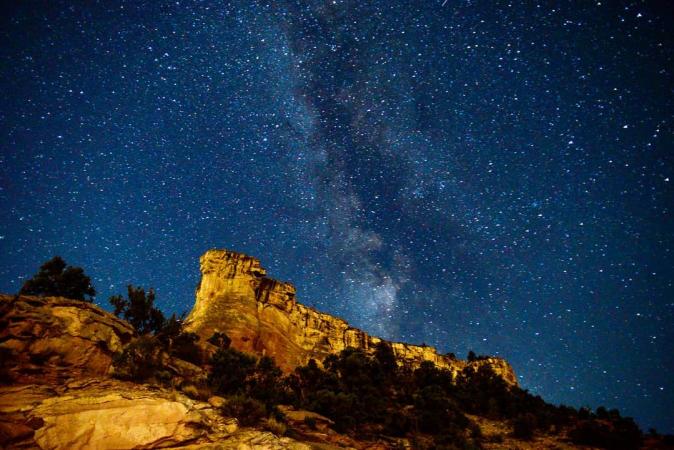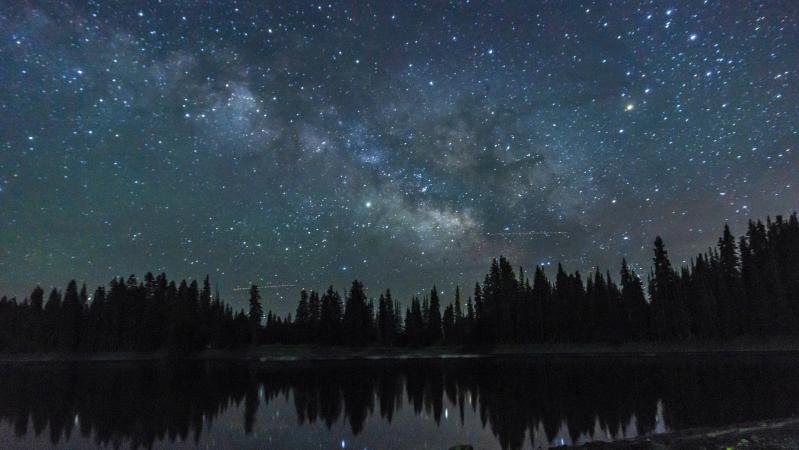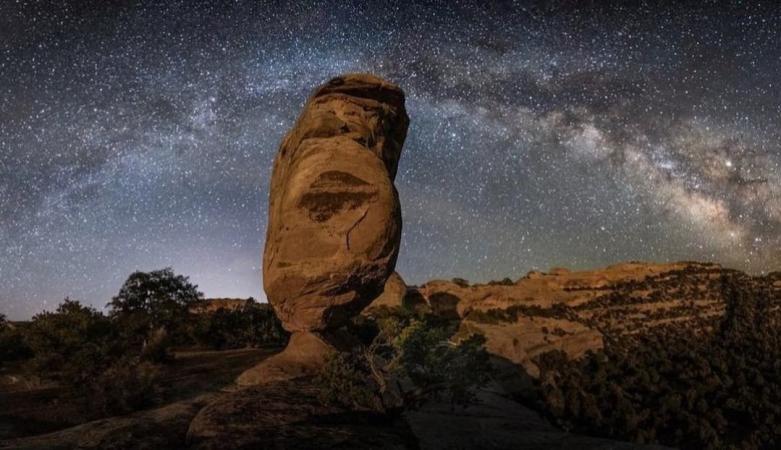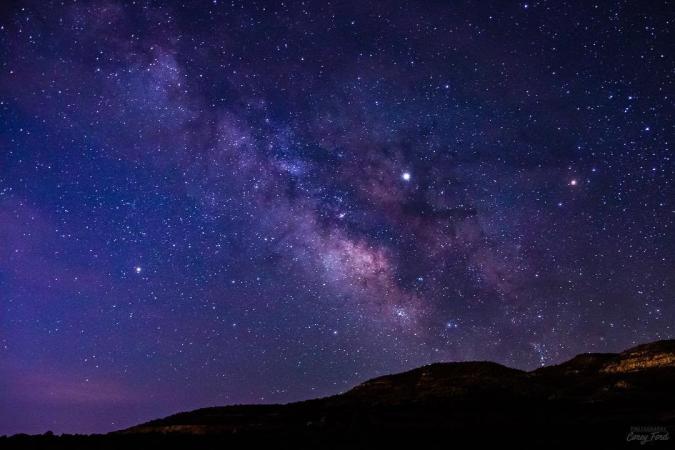Milky Way season is here, so it’s time to wish upon a star! While the Milky Way can be seen all year-round, summer is when viewing is at peak. The Earth is positioned to maximize galaxy viewing around 10:30 pm and stays glimmering all night. During the winter season, the constellations don't completely appear until 3 am and they quickly disappear after just a few hours.
Of course, the real trick to seeing stars shine is escaping the light pollution from cities and towns. While Grand Junction might be the biggest city between Denver and Salt Lake, it also happens to be home to some of the darkest skies you’ll find anywhere, which makes it the perfect place to see the night sky as you’ve never experienced before.
Here are a few of the best places around Grand Junction to catch a glimpse of the universe. Some of these spots are easy to get to, some require a little bit of walking, and others are more challenging to reach, but all offer an unbelievable reward.
Right in Downtown Grand Junction’s back yard is Colorado National Monument, a 20,500-acre labyrinth of canyons, cliffs, and spires. It’s hard to believe such an alien looking landscape exists only ten minutes from town. When the city lights fade away off into the distance, the landscape appears even more alien, backlit by the blanket of stars.
Monument and Wedding Canyons are both filled with impressive rock spires that reach more than 450 feet into the air. Book Cliff View, Grand View, and Otto’s Trail are all picturesque spots to spread out a blanket and watch the sky unfold above. You can drive to Book Cliff View and Grand View or hike on Otto’s Trail for about a quarter-mile from the parking area. Make sure you bring a flashlight!
Don't just watch the stars for a few hours, spend the whole night and camp under them! Saddlehorn Campground in Colorado National Monument is perfect for an overnight excursion. Campsites at A Loop are available year-round, while sites in B Loop are open mid-march through October – reservations required.
Only 45 minutes from Grand Junction, the world’s largest flat-top mountain with over 300 lakes reaches an elevation of over 11,000 feet, towering above the city 6,000 feet below. The Grand Mesa skies are so dark you feel like you are actually within the galaxy you are viewing.
The dense pine forests stand out like jagged teeth against the skyline, creating a dramatically defined horizon. But what really shines, are the 300 lakes sparkling across the Mesa. In the calm of night, the lakes' surface becomes still pools as reflective as a mirror, which only adds to the immersive experience. Once you find your perfect lake, relax shore side and watch the stars move across the sky while reflecting below simultaneously.
You can drive to most of the lakes on the Mesa, but there are some you can hike to if you wish to be more remote. Lost Lake is a great short hike that will make you feel completely isolated. If you’re looking to stay overnight, check out Island Lake & Campground for views of the small island from which the lake draws its name. If you’re looking for a few extra amenities, check out historical Wagon Wheel Restaurant & Motel. The rooms have all the amenities you expect and the restaurant & bar is known for its friendly service and hand-crafted menu that locals often enjoy as well.
While Colorado National Monument and Grand Mesa have plenty of locations to stargaze from, Miracle Rock has one specific destination, but it’s a pretty miraculous one. In Glade Park behind Colorado National Monument, a 12,000-ton boulder sits upright at the end of a ridgeline cliff, perfectly balanced on a beam that, in places, is no wider than 4 inches. Standing over 84 feet tall, this giant rock resembles a potato, but at night it takes on a life of its own.
During the day, Miracle Rock will spark your imagination trying to figure out how mother nature managed to wrangle such a massive boulder into such a precarious position, and the night sky only intensifies the mystery. Witnessing the bright belt of the Milky Way arc over a 24,000,000-pound potato is about as otherworldly as it gets.
While it’s about a 40-minute drive from Grand Junction to the Miracle Rock parking lot (albeit a gorgeous drive with breathtaking overlooks), the hike to the actual rock is only a half mile. With a flashlight, the trail is easy to navigate. As you approach Miracle, be sure to use caution and watch your step, there is a cliff drop-off. If you choose to camp in the area, make sure you adhere to the Bureau of Land Management’s guidelines for dispersed camping.
Lovingly called Moon Rock by some locals, this big flat rock will make you feel as though you’re walking on the moon. While the Ribbon trail is a popular mountain bike trail known for its steep descents and technical features, it’s an easy half-mile hike from the upper trailhead to this big moon-like surface.
To reach the upper trailhead, drive up Little Park Road about eight miles until you see a sign for the Ribbon on your right. Head down the trail about a half mile until you find the giant white rock. This moon-like surface extends up above the surrounding landscape, coupled with steep drops on all sides - it feels as though you’re actually on the moon, adrift in space. With 360-degree panoramic views, the majesty of the sky will envelop you. The only thing anchoring you to Earth is the sparkle of the city lights, far below on the valley floor.
The hardest to reach but offering the potential for the most stunning rewards is Rattlesnake Arches in McInnis Canyons National Conservation Area. This is a difficult hike, about 7.5 miles each way, and hikers should be prepared and experienced before making the trek.
If you do make the trek, you’ll discover the second largest concentration of natural arches in the world, second to Arches National Park in Moab. These giant free-standing arches, land bridges, and windows create striking portals to the Milky Way that provide endless vantages of the sky above. For a more in-depth view of how to explore this unique and remote area, check out the Rattlesnake Arches blog post.
If you plan on making the trip in the day and camping out overnight, it’s important to note that camping is not allowed within a quarter mile of the Rattlesnake arches loop, along the last 1.5 miles of the upper access road or at the trailhead. As long as you follow these restrictions and camp on a durable surface like packed dirt or rock (not vegetation) you are free to find your perfect site. Be sure to adhere to BLM dispersed camping guidelines, current fire restrictions and Leave No Trace. Help make sure places like this stay pristine for everyone.
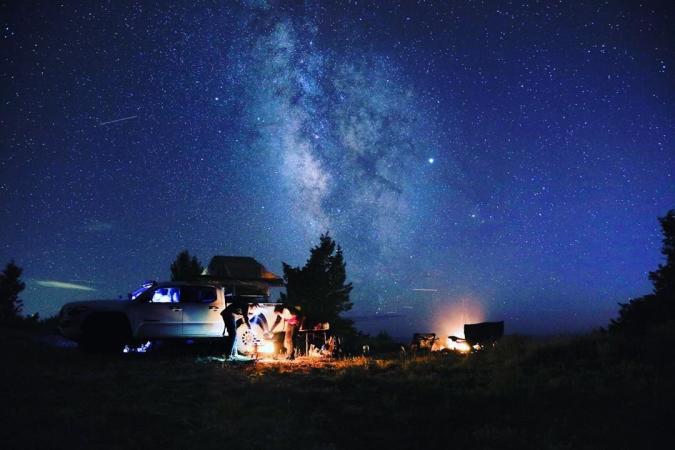
Always be prepared and know before you go. If you have never been to a particular location before, arrive early to avoid hiking after nightfall, or go a day in advance to scout locations, trails, and potential hazards. Check the weather, dress accordingly and bring layers along with plenty of water and food. Seeing the night sky bursting with stars while you view the Milky Way is an incredible experience that is very grounding and will shine bright in your memories for years to come.
Thinking about stargazing in the Colorado National Monument? Check out the Official Grand Junction Visitor Guide!

